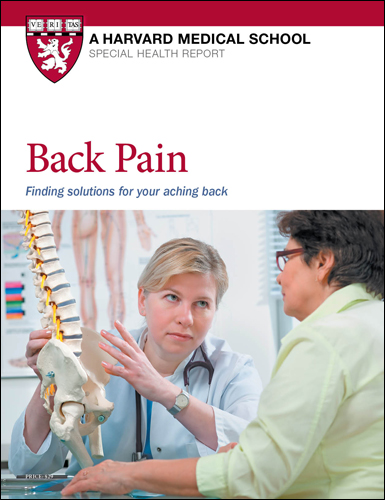Harvard Health Blog
Navigating back pain treatments: Can a physiatrist help?

If self-care steps for back pain such as gentle activity, local heat, or massage don't ease discomfort within a few weeks to a month, or if you struggle with chronic low back pain, a physiatrist can help you navigate the dizzying number of treatment options. These range from conservative therapies (such as medicines, physical therapy, and chiropractic care) to more invasive options (such as spine injections and spinal surgery).
What is a physiatrist?
Physiatrists are medical doctors who specialize in physical medicine and rehabilitation. We focus on holistic, nonsurgical care aimed at improving function for people who are affected by diseases of the brain, spinal cord, nerves, bones, joints, ligaments, muscles, and tendons. We often lead a team of medical professionals that may include physical therapists and occupational therapists. We collaborate with other physicians, such as primary care doctors, neurologists, orthopedic surgeons, neurosurgeons, and others.
When should I see a physiatrist?
Most people will experience back pain at some point in life. Often, self-care steps suggested by a primary care provider offer sufficient relief. But if back pain persists, or if a pattern of back pain develops, a physiatrist can help you find the right combination of treatments to improve your pain and ability to do everyday tasks and activities you enjoy.
What could be causing my back pain?
Back pain may stem directly from the spine or supporting muscles. Or it may be referred pain from other areas of the body.
The lower back is the most common location for back pain. While it's not always possible to determine the exact cause of pain, a physiatrist will consider many common and less common possible sources to help create a treatment plan.
Common sources of low back pain include:
- Intervertebral disc degeneration. Wear and tear changes occur over time in the discs between the lumbar vertebrae. These discs help absorb impact in the spine. Degeneration also includes disc bulges and disc herniations, which can irritate nearby nerves and cause leg pain. This condition can cause low back pain when bending forward and/or sitting for prolonged periods.
- Spinal stenosis. The narrowing of the channel inside the spine where spinal nerves travel can cause leg pain with standing and walking.
- Lumbar facet joint osteoarthritis. Facet joints are small joints that help stabilize the spine as you bend or turn. This condition can cause low back pain with standing and walking.
- Hip joint arthritis. This sometimes creates referred pain in the buttocks and low back.
- Sacroiliac joint dysfunction. This can cause pain in the buttocks and low back.
Less common sources of low back pain include:
- fractures, including compression fractures of the vertebrae, which may be due to osteoporosis
- infection
- cancer
- autoimmune disease.
What treatment will a physiatrist provide?
A physiatrist will take a thorough history and perform a comprehensive musculoskeletal and neurological exam to hone in on your diagnosis. If the findings warrant follow-up, he or she may order additional tests. These may include further blood work, imaging tests like x-rays, MRIs, or CT scans, and studies of nerve conduction and electrical activity in the muscles (electromyography). Because physiatrists have comprehensive training in musculoskeletal and neuromuscular medicine — which covers muscles, bones, and nerves throughout the body — we are especially adept at diagnosing potential sources of back pain.
Ultimately, treatment will depend on the suspected cause, or causes, of your back pain. Medications may include nonsteroidal anti-inflammatory drugs (NSAIDs), non-benzodiazepine muscle relaxants, or acetaminophen. Rarely, a short course of opioids is suggested for severe pain. For some patients, evaluation and treatment with a physical therapist may be important to work on correcting poor posture, improving ergonomics at work or home, and stabilizing the low back by strengthening muscles. Many other types of noninvasive treatments may be suggested during your evaluation. You can discuss potential advantages and disadvantages, and the likely effectiveness of all the options recommended, with your physiatrist during your evaluation.
When more treatment is needed
When people have severe pain, or have not found enough pain relief with conservative treatments, physiatrists who are trained in peripheral joint injections and spinal injections can offer these procedures. There are many different types of diagnostic and therapeutic spine injections, each of which target different causes of back pain. A physiatrist who specializes in spine care can help explain the risks and goals of these treatment options.
Many people find that conservative care or injections offer sufficient relief from back pain. However, when this is not enough, or in rare cases when people are experiencing progressive neurological problems, a physiatrist can also help you make the decision to see a surgical specialist.
Physiatrists are able to offer a broad range of nonsurgical treatment options for back pain at any step along the way. By providing a holistic approach, we collaborate with people to create a customized treatment plan for their needs that focuses on improving their ability to function, work, and enjoy recreational activities. To find a physiatrist in your area, ask your doctor or health plan for a referral, or locate one through the American Academy of Physical Medicine and Rehabilitation.
About the Author

Edward N. Wei, MD, Contributor
Disclaimer:
As a service to our readers, Harvard Health Publishing provides access to our library of archived content. Please note the date of last review or update on all articles.
No content on this site, regardless of date, should ever be used as a substitute for direct medical advice from your doctor or other qualified clinician.
















